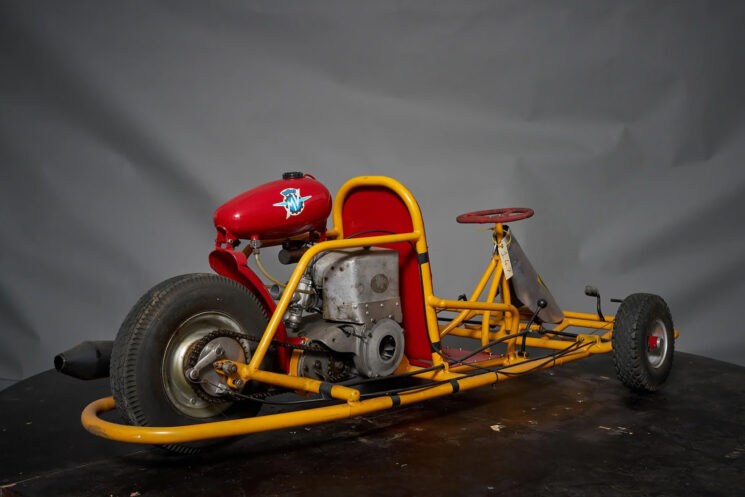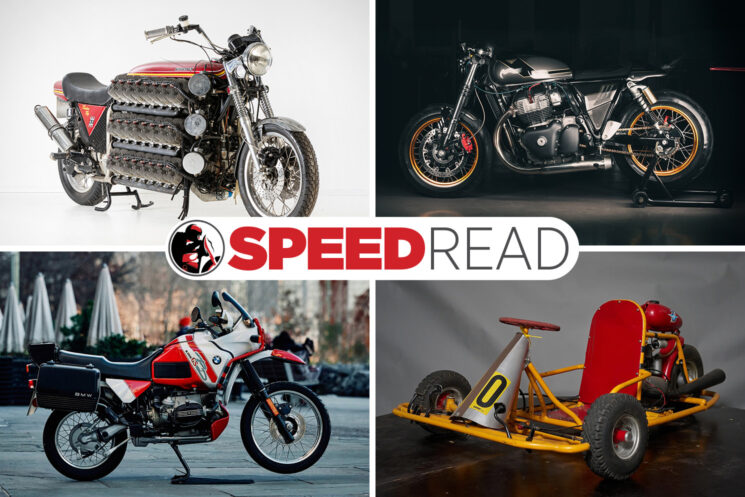
This might just be our most eclectic Sunday round-up yet. We start with a Guinness World Record-holding 48-cylinder Kawasaki two-stroke, then look at a Royal Enfield Interceptor 650 café racer from Mumbai. Rounding out our list are an untouched 1995 BMW R100GS PD and an MV Agusta go-kart (yes, really).
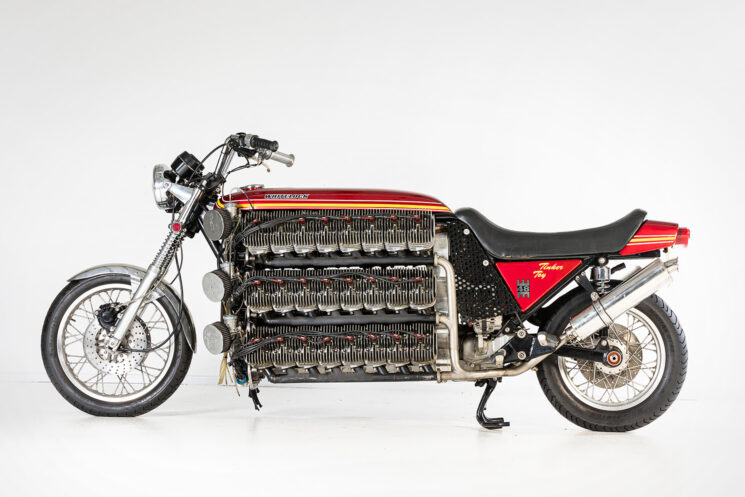
Whitelock 4.2-liter 48-cylinder Kawasaki Simon Whitelock has a particular penchant for Kawasaki triples and has been building one-off motorcycles since 1985. Like any drug, vice, or level of insanity, Whitelock started easy and casual, by first building an inline four-cylinder Kawasaki two-stroke from other engines. After that, it was a nine-cylinder ‘triple-triple’ and an inline seven-cylinder.
They were all Kawasakis and all two-strokes. But this addiction needed feeding, and this is what led to the Guinness Book of World Record-holding 48-cylinder Kawasaki two-stroke you’re looking at here.
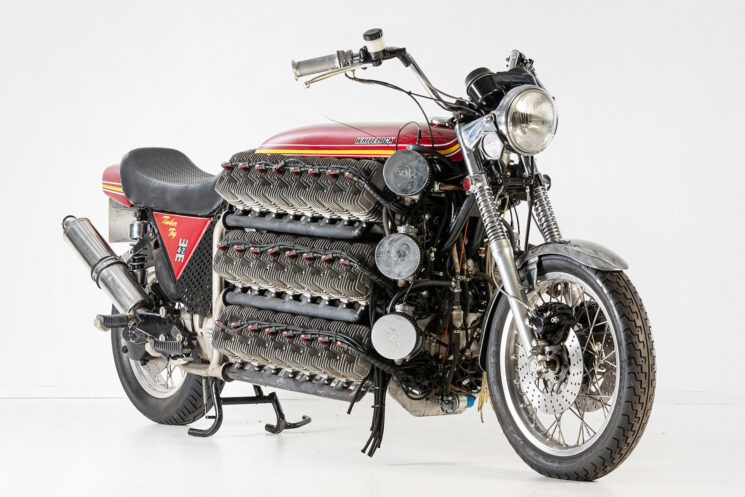
Nicknamed ‘Tinker Toy’ after a B-17 Flying Fortress bomber from WWII, Whitlock’s creation is built from six banks of eight cylinders each. All the engine parts are from Kawasaki KH250 donors, which Whitlock chose because parts were plentiful and cheap. (Our math yields well over $100 in spark plugs alone.)
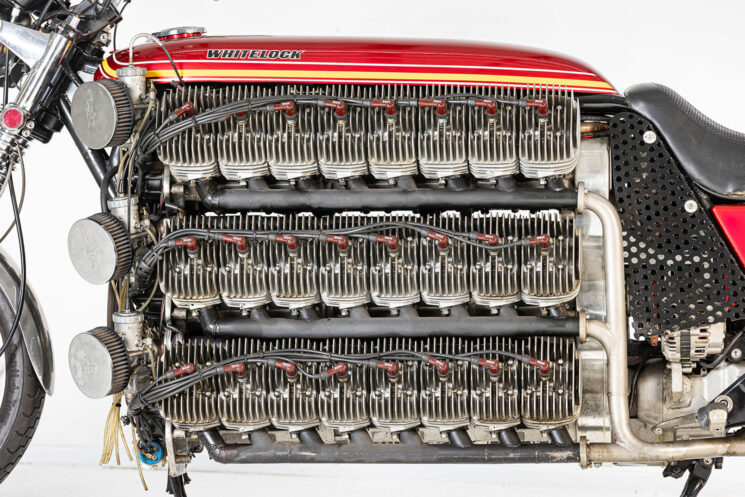
The bike satisfies all legal requirements in England, where it holds a full license. It’s running a one-off engine block with custom fuel and ignition systems, along with a BMW K100 gearbox, and an alternator borrowed from a car. It’s a hefty bit of kit (weighing around 1,300 lbs), so it rolls on heavy-duty Hagon wheels with stainless steel spokes and wears a Honda Goldwing front end.
To start this 48-cylinder monster, Whitelock had to rig up another 125 cc mill engine to use as a ‘donkey engine.’ Technically, that makes this a 49-cylinder motorcycle—although the donkey engine is switched off after all the other cylinders are running, just like a starter motor.

We mentioned the Guinness World Book of Records; the record this bike holds is for the most amount of cylinders in an engine for a land vehicle. It’ll be going up for sale in April over at Bonhams, with a price guide from $50,000 to $75,000.
It doesn’t ride too well, but it would make a great addition to any eclectic collector—and just imagine starting it up for your friends at every shed session. [Source]
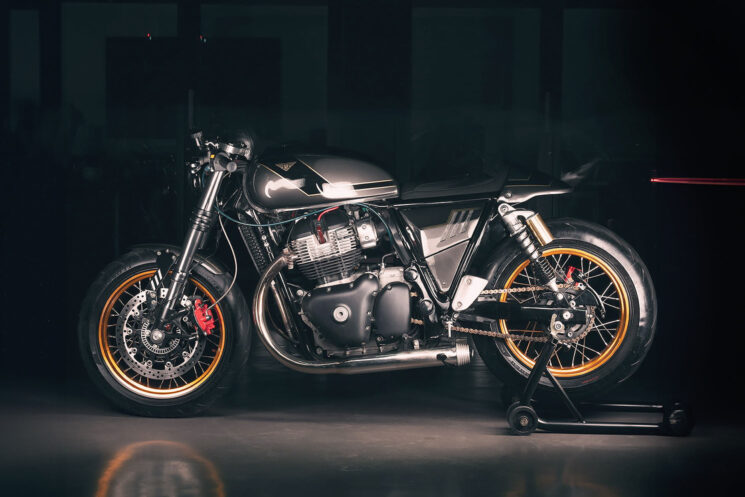
Royal Enfield Interceptor 650 by Mean Green Customs One more time for the people at the back; if you haven’t sampled Royal Enfield’s modern 650 twins yet, you really should. They’re good-looking, easy-going bikes—and, as we’ve seen countless times in the six or so years that they’ve been on the market, they’re great for customization.
This custom Royal Enfield Interceptor 650 (or INT650, if you’re in the States) from Aditya Deshmukh’s Mean Green Customs in Mumbai proves that point once again. Aditya has taken the already-handsome retro standard and turned it into a lithe, sharp café racer.
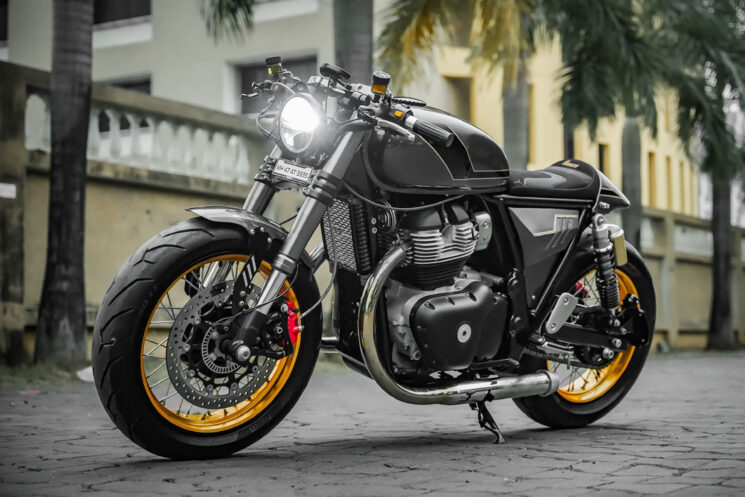
The standard 18” wheels were swapped out for a set of gold 17s, now fitted with sticky-as-heck Pirelli Diablo Rosso II tires. The yokes and 43 mm upside-down Showa forks from a Ducati Panigale V4 sit up front, along with a custom-made fender. Aditya retained the Enfield’s piggyback rear shocks and ByBre brake calipers.
A Motogadget Motoscope Pro dashboard was fitted, along with Motogadget indicators and a bottom-mount LED headlight. Very racy clip-on bars were slipped on too, with a new radial brake master cylinder on the right and a hydraulic-converted clutch setup on the left.
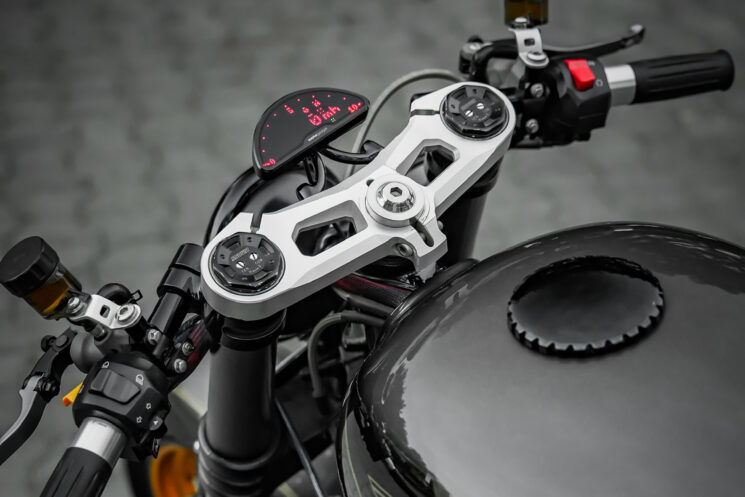
Aditya kept the factory fuel tank, which has a lovely shape straight out of the box. It’s been tarted up with fresh paint, with Mean Green logos matching the custom Mean Green oil-cooler shroud. Custom side covers sit below a one-off seat, which is upholstered in black Alcantara and leather.
The subframe was cut back, looped, and covered with a custom-made tail unit. An LED taillight runs the vertical length of the tail unit; a neat touch that gives this café racer an edge.
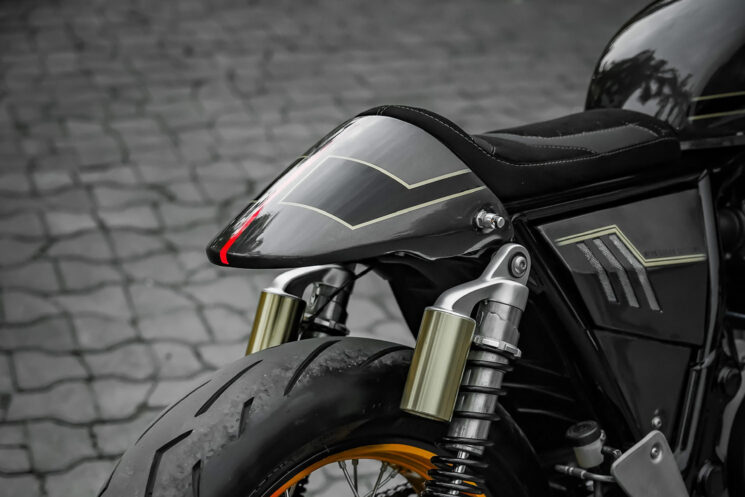
The Interceptor’s engine is a real peach, but Aditya still fitted a free-flowing exhaust and a BMC air filter to help it breathe. The front and rear sprockets were swapped out to improve the gearing, while the rocker cover and engine cases were blacked out to match the moody paint scheme.
Royal Enfield’s 650 twins really have become darlings of the custom world—and Aditya has reminded us why. [Source]

For sale: BMW R100GS PD at Moto Borgotaro Of all the classic adventure bikes we would like parked in the Bike EXIF garage, the BMW R100GS PD ranks high. Made in limited numbers, the late-model airhead Beemer oozes 90s charm and nostalgia. Couple the cool factor with outlandish paint, rugged reliability, and a go-anywhere aesthetic, and it’s easy to see why this is a winning formula.
The ‘PD’ stands for ‘Paris-Dakar,’ in reference to the famed Dakar Rally. Rumor has it that BMW couldn’t use ‘Paris-Dakar’ at the time for legal reasons, so they shortened it to ‘PD.’
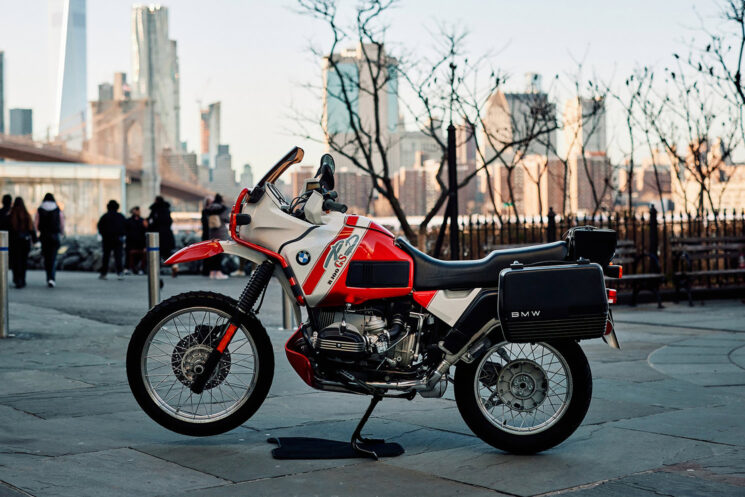
The R100GS PD boasted BMW’s range-topping trim level at the time, and as such got a few extras compared to the standard R100GS. This included a larger tank with a locking compartment, a three-part engine, exhaust and sump protector, and a larger fairing (to match the larger tank). There was also a square headlight protected by integrated crash bars, heated grips, and an adjustable windscreen.
This particular example is a 1995 BMW R100GS PD—which is significant because that was the last year that BMW produced the classic airhead boxer motor.
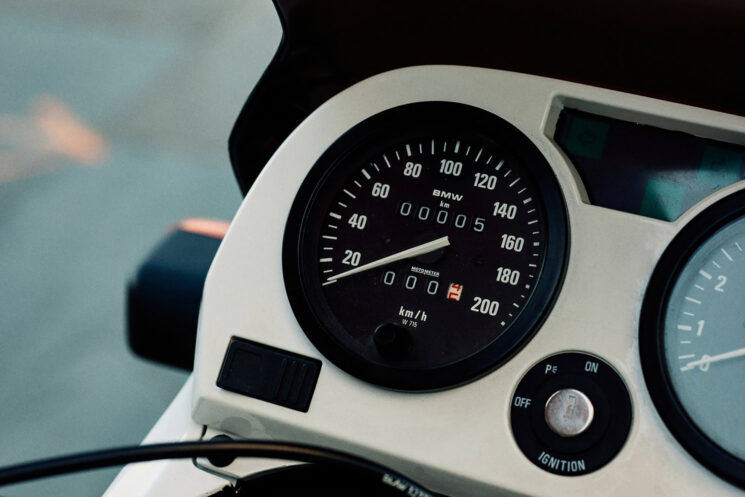
The optional high front fender and a full set of cases aren’t the only reasons why this bike looks so good though. Unbelievably, it only has 5 km [3.1 miles] on the odometer. It was carefully uncrated and preserved in a climate-controlled BMW dealership in Germany, as evidenced by the condition of the paint and plastics.
This bike, in essence, presents in an as-new, original delivery condition—which is quite rare for a bike of this age and intent.
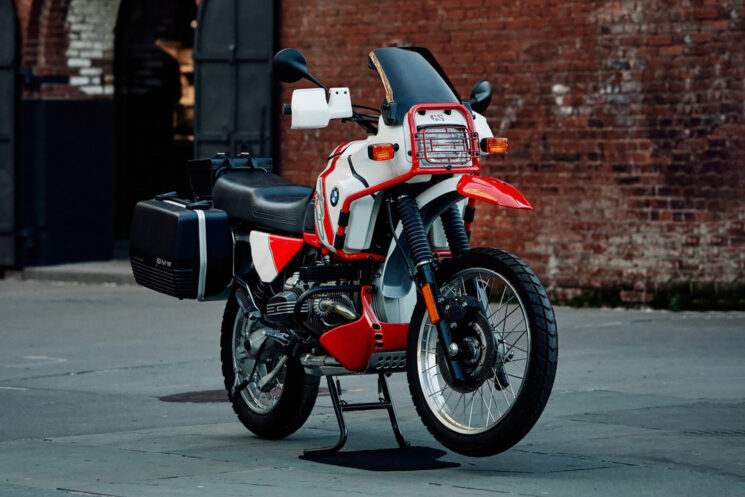
The R100GS is currently in the capable hands of Moto Borgotaro in Brooklyn and is up for sale. It comes with two seats (a dual unit, and a solo unit with a luggage rack), a complete luggage system, and a complete and original tool kit. A leather rear accessory box, a second clear windshield, and all delivery booklets are included.
The $75,000 asking price is steep, but opportunities to buy a brand new 1995 BMW GS only occur once in a blue moon. [Source]
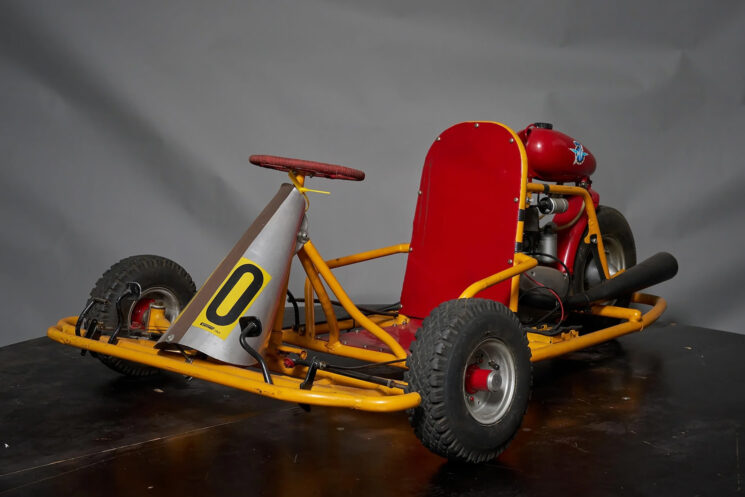
3-wheeled MV Agusta go-kart If we asked you what is red, yellow, and from the 1950s, the chances of you guessing a 125 cc three-wheeled MV Agusta go-kart. Yet here we are.
Constructed from an unknown-but-more-than-likely-steel tubular frame, this weird ball of fun is our idea of a great time with the kids (whether grown-up or not). The 125 cc four-stroke motor is from a 1950s MV Agusta, which gives this kart more than a little racing pedigree. In their heyday, MV Agusta racked up 37 World Championships and 270 Grand Prix victories, and some of their astonishing records still stand to this day.
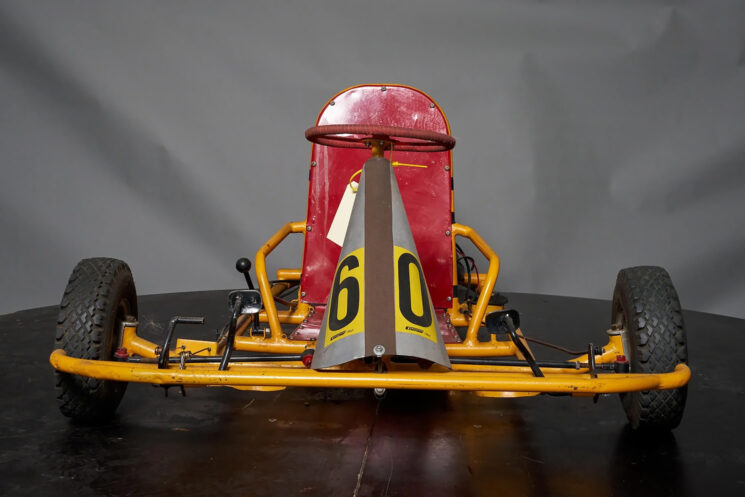
As for the kart, it’s unlikely to ever be entered into competition again, but it’s fun to look at. The three-pedal setup means that this is a ‘shifter kart’—something that is only reserved for rather quick racers and kart aficionados. The MV Agusta engine looks to have been outfitted with a rudimentary turbo-fan air-cooling system mounted on the flywheel; the aluminum box on the right-hand side of the engine more than likely feeds air through the cooling fins and out the other side.
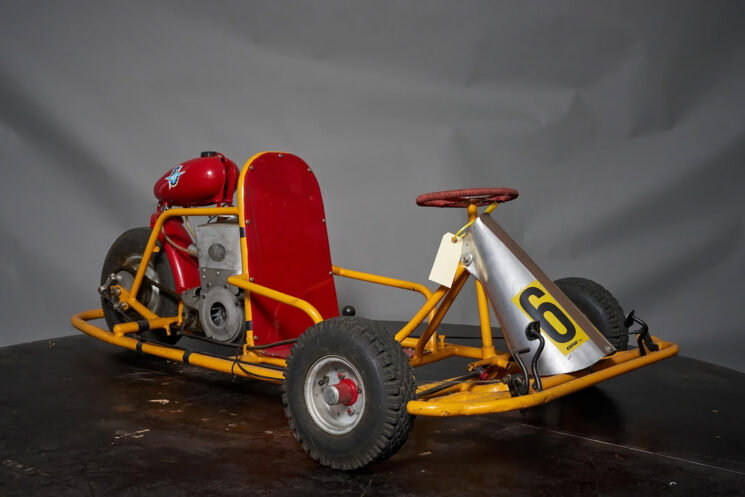
The tank uses gravity to feed the single carb, and is mounted on top of the engine and rear fender. The engine drives a single rear wheel via a chain final drive, just like a motorcycle. There is only one brake—a confidence-inspiring drum at the back—and the seating arrangement is rather utilitarian.
Some lucky sod bought this historic bundle of joy for $4,350 through Bonhams… making us more than just a little jealous in the process. [Source]
